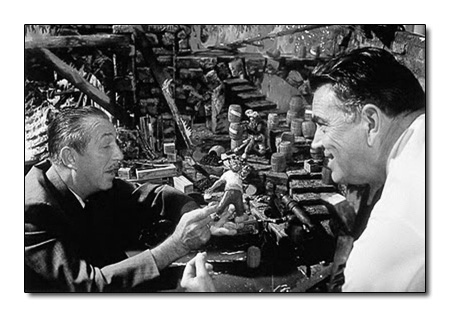Claude Coats
HomeFor over 50 years, Claude Coats was a major creative force at the Walt Disney Company. As an artist, he was a master of color, light and mood for classic Disney films. As an Imagineer, he created evocative three-dimensional experiences for Disney theme park attractions. Claude leaves a lasting legacy of design and entertainment enjoyed by millions of movie viewers and park visitors around the world.
It was Claude’s membership in the Water Color Society that opened the door to his 54 year long career at Disney. Phil Dike, a fellow member of the Society and Disney artist, recognized Claude’s talent and suggested that he interview with the studio. Under Dike’s guidance, Claude compiled a portfolio of background paintings that complemented the style of Disney cartoons that he had seen. Claude interviewed at Disney’s Hyperion Avenue studio in East Hollywood and was hired as an apprentice background painter in June of 1935.
Claude’s first assignments included the cartoons Mickey’s Fire Brigade and Pluto’s Judgment Day. Over the next 20 years, Claude would contribute backgrounds and color styling to such Disney classics as Snow White and the Seven Dwarfs, Pinocchio, Lady and the Tramp, Fantasia, Dumbo, Peter Pan, Alice in Wonderland, and Cinderella.
Claude also painted backgrounds for many of the Silly Symphony musical shorts. He was a member of the Short Subjects Branch of the Academy of Motion Picture Arts and Sciences. His eye for color and mood added a unique look to the Oscar winning films The Old Mill (1937) and Ferdinand the Bull (1938).
In 1955, Claude joined the staff of WED Enterprises (now Walt Disney Imagineering) to lend his creative talents to the opening of Disneyland. “I had a break in my background work where I wasn’t busy, so I got to do the model for the Mr. Toad attraction.” Ken Anderson had done development work on the ride, but with opening day fast approaching the scenic studio hired to paint the full size settings informed Walt that they wouldn’t be finished on time. So Walt said to Ken and Claude, “You guys do it.”
Thus began what Claude would describe as his “second career” at Disney, doing “big backgrounds” as art director and show designer for memorable Disneyland attractions including the Haunted Mansion, Pirates of the Caribbean, Grand Canyon Diorama, Alice in Wonderland, and the Submarine Voyage.
In describing the correlation between his work as a background artist and his work as a show designer, Claude said that in backgrounds he “always thought in terms of mood and color.” He said that various colors and shapes created “emphasis on where you wanted people to watch, and what you wanted them to see, and that’s really the same thing with rides.” In terms of Disneyland attractions, Claude said that “light is always the thing that focuses attention.”
Claude was often the focus of attention himself: all 6 foot, 6 inches. Walt would kid him about his height. As Claude recalled, “When the Disneyland stagecoach was completed at the studio, Walt and a driver were giving rides around the lot, but he wouldn’t let me get in. He said I spoiled the scale.” Sculptor Blaine Gibson remembers, “He was a heck of a tall guy and whenever we went for a walk in the Park, I had to take two steps to his one!”
But the “gentle giant,” as he was often called, never let his stature dominate the work of others. As Gibson recalled, “He was an easy guy to work with and had a wonderful disposition. He could make room for others’ ideas, but he never lost sight of the overall plan on the project.”
For over 35 years, Claude would leave the stamp of his designs on attractions at Disneyland, the 1964 World’s Fair, Walt Disney World’s Magic Kingdom, EPCOT Center, Tokyo Disneyland and Disneyland Paris.
After 54 years in animation and Imagineering, Claude retired in November 1989. In recognition of his remarkable career, Claude was honored with the Disney Legend Award in 1991. At the Award ceremony, he placed his hand prints and signature in concrete outside the Studio theater as a symbol of the permanence of his contributions.
(source: http://www.claudecoats.com/biography.html)


